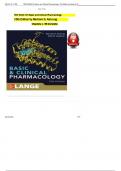8/27/24, 2:41 PM TEST BANK For Basic and Clinical Pharmacology, 15th Edition by Bertram G.…
Page 1 of 822
TEST BANK FOR Basic and Clinical Pharmacol
Pharmacology
ogy
15th Edition by Bertram G. Katzung
Chapters 1 - 66 Compl
Complete
ete
about:blank 1/51
,8/27/24, 2:41 PM TEST BANK For Basic and Clinical Pharmacology, 15th Edition by Bertram G.…
Page 2 of 822
Table of Contents
1. Introduction: The Nature of Drugs & Drug Development & Regulation
2. Drug Receptors & Pharmacodynamics
3. Pharmacokinetics & Pharmacodynamics: Rational Dosing & the Time Course of Drug Action
4. Drug Biotransformation
5. Pharmacogenomics
6. Introduction to Autonomic Pharmacology
7. Cholinoceptor-Activating & Cholinesterase-Inhibiting Drugs
8. Cholinoceptor-Blocking Drugs
9. Adrenoceptor Agonists & Sympathomimetic Drugs
10. Adrenoceptor Antagonist Drugs
11. Antihypertensive Agents
12. Vasodilators & the Treatment of Angina Pectoris
13. Drugs Used in Heart Failure
14. Agents Used in Cardiac Arrhythmias
15. Diuretic Agents
16. Histamine, Serotonin, & the Ergot Alkaloids
17. Vasoactive Peptides
18. The Eicosanoids: Prostaglandins, Thromboxanes, Leukotrienes, & Related Compounds
19. Nitric Oxide
20. Drugs Used in Asthma
21. Introduction to the Pharmacology of CNS Drugs
22. Sedative-Hypnotic Drugs
23. The Alcohols
24. Antiseizure Drugs
25. General Anesthetics
26. Local Anesthetics
27. Skeletal Muscle Relaxants
28. Pharmacologic Management of Parkinsonism & Other Movement Disorders
29. Antipsychotic Agents & Lithium
30. Antidepressant Agents
31. Opioid Agonists & Antagonists
32. Drugs of Abuse
33. Agents Used in Cytopenias; Hematopoietic Growth Factors
34. Drugs Used in Disorders of Coagulation
35. Agents Used in Dyslipidemia
36. Nonsteroidal Anti-Inflammatory Drugs, Disease-Modifying Antirheumatic Drugs, Nonopioid Analgesics, & Drugs
Used in Gout
37. Hypothalamic & Pituitary Hormones
38. Thyroid & Antithyroid Drugs
about:blank 2/51
,8/27/24, 2:41 PM TEST BANK For Basic and Clinical Pharmacology, 15th Edition by Bertram G.…
Page 3 of 822
39. Adrenocorticosteroids & Adrenocortical Antagonists
40. The Gonadal Hormones & Inhibitors
41. Pancreatic Hormones & Antidiabetic Drugs
42. Agents That Affect Bone Mineral Homeostasis
43. Beta-Lactam & Other Cell Wall- & Membrane-Active Antibiotics
44. Tetracyclines, Macrolides, Clindamycin, Chloramphenicol, Streptogramins, & Oxazolidinones
45. Aminoglycosides & Spectinomycin
46. Sulfonamides, Trimethoprim, & Quinolones
47. Antimycobacterial Drugs
48. Antifungal Agents
49. Antiviral Agents
50. Miscellaneous Antimicrobial Agents; Disinfectants, Antiseptics, & Sterilants
51. Clinical Use of Antimicrobial Agents
52. Antiprotozoal Drugs
53. Clinical Pharmacology of the Antihelminthic Drugs
54. Cancer Chemotherapy
55. Immunopharmacology
56. Introduction to Toxicology: Occupational & Environmental
57. Heavy Metal Intoxication & Chelators
58. Management of the Poisoned Patient
59. Special Aspects of Perinatal & Pediatric Pharmacology
60. Special Aspects of Geriatric Pharmacology
61. Dermatologic Pharmacology
62. Drugs Used in the Treatment of Gastrointestinal Diseases
63. Therapeutic & Toxic Potential of Over-the-Counter Agents
64. Dietary Supplements & Herbal Medications
65. Rational Prescribing & Prescription Writing
66. Important Drug Interactions & Their Mechanisms
about:blank 3/51
, 8/27/24, 2:41 PM TEST BANK For Basic and Clinical Pharmacology, 15th Edition by Bertram G.…
Page 4 of 822
Chapter 1. Introduction: The Nature of Drugs & Drug Development & Regulation
1. A nurse working in radiology administers iodine to a patient who is having
a computed tomography (CT) scan. The nurse working on the oncology
unit administers chemotherapy to patients who have cancer. At the Public
Health Department, a nurse administers a measles-mumps-rubella
(MMR) vaccine to a 14-month-old child as a routine immunization. Which
branch of pharmacology best describes the actions of all three nurses?
A) Pharmacoeconomics
B) Pharmacotherapeutics
C) Pharmacodynamics
D) Pharmacokinetics
ANSWER: B
Feedback:
Pharmacology is the study of the biologic effects of chemicals. Nurses are
involved with clinical pharmacology or pharmacotherapeutics, which is a
branch of pharmacology that deals with the uses of drugs to treat,
prevent, and diagnose disease. The radiology nurse is administering a
drug to help diagnose a disease. The oncology nurse is administering a
drug to help treat a disease. Pharmacoeconomics includes any costs
involved in drug therapy.
Pharmacodynamics involves how a drug affects the body
and pharmacokinetics is how the body acts on the body
2. A physician has ordered intramuscular (IM) injections of morphine, a
narcotic, every 4 hours as needed for pain in a motor vehicle accident
victim. The nurse is aware this drug has a high abuse potential. Under
what category would morphine be classified?
A) Schedule I
B) Schedule II
about:blank 4/51




